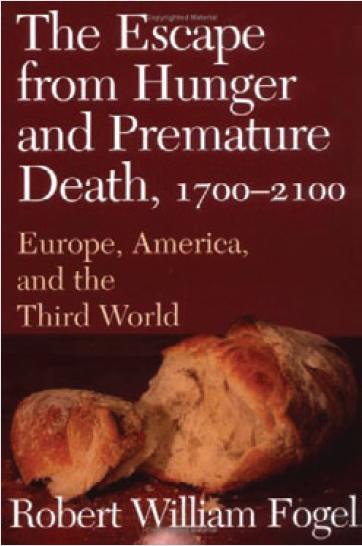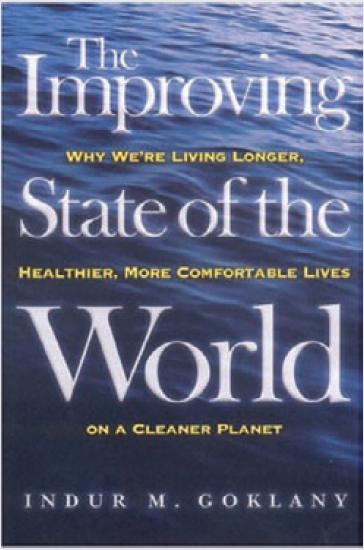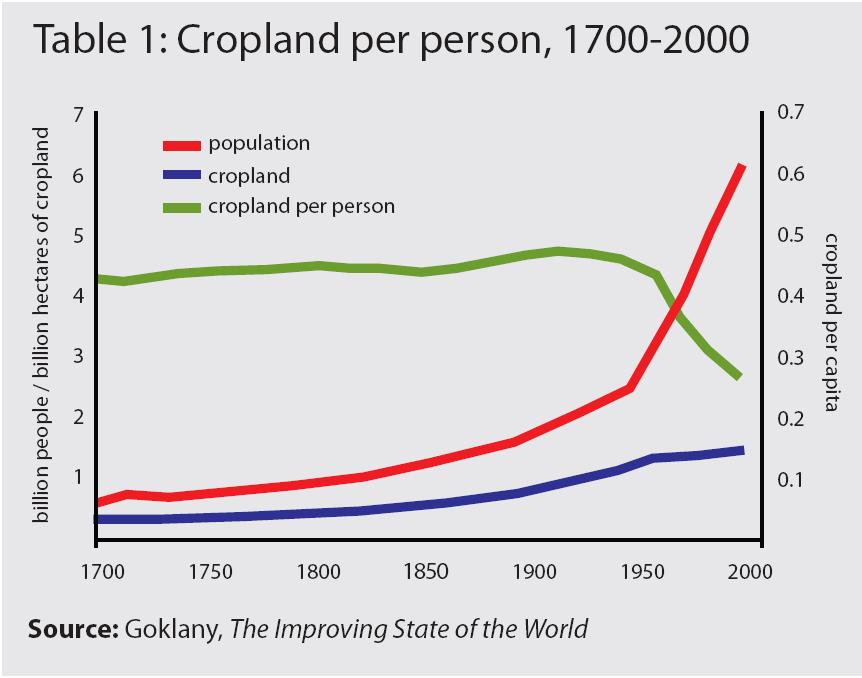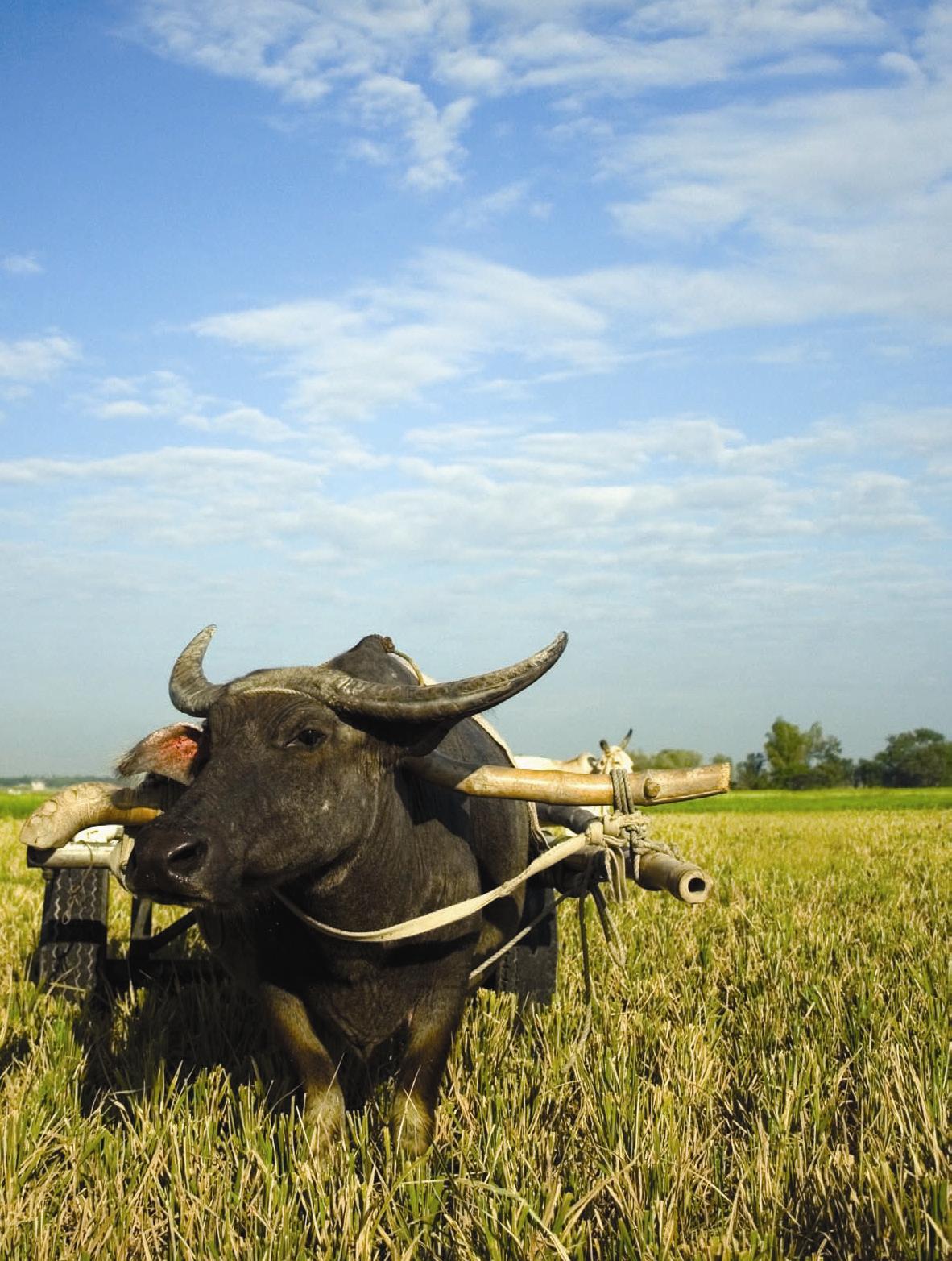The Improving State of the World: Why We're Living Longer, Healthier, More Comfortable Lives on a Cleaner Planet
by Indur Goklany
(Cato Institute, 2007, 450 pages)
The Escape from Hunger and Premature Death, 1700-2100: Europe, America, and the Third World
by Robert William Fogel
(Cambridge, 2004, 216 pages)
Contours of the World Economy 1-2030 AD: Essays in Macro-Economic History
by Angus Maddison
(Oxford, 2007, 448 pages)
In 1850, London was a miserable place. A baby boy born in that year and at that location could only expect to live to 40.
The world that baby was born into had raw sewage running in the streets, heavy fogs of air pollution and such putrid drinking water most people drank beer. A mere one hundred years later -- within the lifetime of that baby's grandchildren -- a child born in England could expect to live to 73.
The story of what happened to make this possible demonstrates the capacity of societies to adapt in positive ways to change and provides evidence to argue the future will be much brighter than the past.
The casual consumer of current affairs could be forgiven for concluding we are all going to hell in a handbasket -- the never-ending procession of depressing stories report that there is a rainforest disappearing here or a famine there, the monotony only broken up with truly horrific disasters like the 2006 Boxing Day tsunami. And the solutions to future catastrophes proposed are even gloomier -- Jared Diamond would like to force population control on the developing world, and rich countries seem intent on imposing a myriad of micro controls on consumer behaviour. But what all of these proposals share is a profound pessimism -- at worst the world's population has to reduce consumption (that is, wealth) substantially, and at best it just needs to share around the current amount. With all this gloom it is a rare person who thinks that, by and large, the massive gains in health and wealth over the past century will be repeated in this one.
But this pessimism doesn't match the empirical evidence. Two recent books, Robert Fogel's The Escape from Hunger and Premature Death, 1700-2100: Europe, America, and the Third World and Indr Goklany's The Improving State of the World: Why We're Living Longer, Healthier, More Comfortable Lives on a Cleaner Planet reveal that these perceptions do not match the reality. Contrary to the depressing prognostications of Ian Lowe, Al Gore, James Lovelock and Jared Diamond, the world is, indeed, getting better.

But just how these improving conditions reveal themselves is instructive. In the nineteenth century Dutch men were on average 164cm (5' 4") tall. Today the average Dutch man is 181cm (6'). All other rich nations show similar, if slightly less pronounced, increases in height. As Nobel Prize winning economist Robert Fogel shows in The Escape from Hunger and Premature Death, the reason for this dramatic height increase was the eradication of the persistent and prevalent malnutrition that existed prior to the industrial revolution. Fogel's demonstrates clearly the link between economic development and nutrition. Until the 1880's, most people just didn't get enough food to do a full day's work and as a result they were not productive as required to earn what they needed to buy enough to eat. This vicious circle existed until the massive leaps in productivity from the industrial revolution were coupled with the equally important transformations in public health and sanitation. Together, these factors meant that all people, most especially the poorest, had the energy to be productive members of society to the benefit of all.
HOW DEVELOPING NATIONS COULD GO FROM WOOD-FIRED
STOVES TO PINK REFRIGERATORS IN JUST 22 YEARS
One of the outcomes of Fogel's work is an understanding of the symbiosis between nutrition, sanitation and technological progress. Instead of technological improvements merely facilitating physiological improvements, for example when the invention of a vaccine eliminates a lethal disease, it now appears that improvements in nutrition and physiology contribute significantly to the process of economic growth and technological progress. By feeding the world properly the current enormous drain on the world's resources through subsistence is eliminated enabling humanity to develop the technologies necessary to drive further advances in the future.

In his The Improving State of the World, Indur Goklany reveals that as societies get richer their impact on the environment at first goes up before declining significantly and then levelling out. At first, people place the highest priority on economic development -- alleviating the cold is more important than avoiding bad air pollution from burning wood and coal inside the home -- and due to lack of education or knowledge people may in fact be unaware of environmental problems. But as a society becomes wealthier and gains more knowledge, reducing environmental impacts rises on its priority list. Certainly, working out how to do so can be a slow process. As a consequence, those societies developing first take longer than those who can simply copy what worked -- Japan's rapid industrialisation after the Second World War benefited enormously from the experience of western industrialisation. What this means is that there is no logical reason to assume that today's developing nations will need to wreak the environmental havoc seen when Europe and Northern America industrialised. Nor is there any necessity to attempt to limit China and India's quest for developed world living standards. Indeed, the evidence from Fogel and Goklany suggests that the planet is best served by pursuing global growth towards new technological frontiers.
If developing countries are allowed to pursue growth without being limited, then they will have a greater chance of lifting out of mass poverty to the point where they voluntarily seek improved environmental outcomes. A corollary of this is that the rules which the developed world attempts to impose upon developing nations will, in the long run, harm, rather than help the environment. For example, European import laws that force Chinese factories to match Europe's air pollution standards reduce China's growth and therefore reduce China's capacity to lift very poor people out of poverty -- rather than allowing China to decide when improving air pollution is a priority.
The advocates of imposing developed world environmental rules on the developing world assume that the only way to achieve improved environmental outcomes is to legislate. Yet this has not been the experience of the developed nations. Clean air and water laws were enacted in the United States inearly 1970's, but the major improvements in cleaning up air and water-borne pollutants occurred much earlier. Indeed, most pollutants peaked in the 1950s and 1960s and declined thereafter -- well before environmental legislation, as individuals and firms gave themselves the benefit of breathable air and safe drinking water. The force of law is useful in forcing laggards to catch up with society's evolving standards but its main value comes after the society has voluntarily adopted those standards.
The group of activists who see the world as a glass half-empty have a patron saint in Thomas Malthus, the eighteenth century English economist most famous for predicting population growth will always outstrip food production leading to "gigantic inevitable famine". Today's neo-Malthusians blame environmental problems as a product of population, affluence and technological progress, and believe that technology is unable to keep-up with the destruction on the environment. They disregard the evidence that shows how rising affluence has been correlated with a cleaner environment in every society, and contend that humanity is now at a tipping point; unable to develop the needed new technologies to avert the apocalypse. And all this gloom is before any discussion of global warming evaporates what little joy remains for these doomsayers.
Goklany collects an impressive amount of evidence to refill the half-empty glasses of the pessimists. On every measure -- life expectancy, healthiness, access to clean water, infant mortality, child labour or literacy rates -- global measures of the human condition show an improvement, not backsliding. Most people alive today are poor, but they are less poor than they were and, with the sorry exception of sub-Saharan Africa, are continuing to both grow richer and dramatically improve the quality and length of their lives.

The pattern of improvement over even just the past fifty years is evident in many other key indicators of wellbeing -- global infant mortality has fallen from 157 deaths per 1,000 live births to 57 today, about where the developed world was in 1955. Malnutrition has declined dramatically, particularly for the forty per cent of the planet's population living in China and India where food supplies have increased 80 per cent and 50 per cent respectively. Education is an important precondition for improvements in a range of life giving behaviours such as sanitation, nutrition and hygiene, as well as the key driver of technology adoption that leads to greater development. Between 1970 and 2000 global illiteracy rates dropped from 46 per cent to 18 per cent. Instead of almost half the world's population being unable to read, that figure is now fewer than one in five.
For the first time in history less than fifty per cent of the world's population are absolutely poor but even more revealingly, the absolute numbers of the poorest have stabilised since 1950 despite a doubling of the total human population in that time.
While income is not a perfect indicator of wellbeing, the biggest issue confronting the world's leaders today must still be poverty reduction. Despite impressive advances over the past 50 years, 2.7 billion people lived on less than US$2 a day in 2001 while the comparable measure for the average person in a developed country is US$100 a day, fifty times that of the poorest. In a compelling rebuttal to the popular view that globalisation is driving inequality, average global income inequality has decreased over the past fifty years although remains at unacceptable levels.

There are persuasive reasons to believe that the eradication of utter poverty can be achieved over the next century. Doing so remains the single most humanitarian act possible. And it does not take heroic growth assumptions to envisage it. In his sweeping 2008 survey of global economic history, Contours of the World Economy, 1-2030 AD, Angus Maddison coalesces the current state of thought on long-run economic growth to venture into predicting the next thirty years. The world economy grew by 3.9 per cent annually from 1950 to 2003. The per capita GDP of poor countries more than trebled from US$1,094 to US$3,816 over that period despite a doubling of population. Over that period the average annual rate of GDP growth for poor countries was 4.3 per cent with China delivering an astounding 8.6 per cent annual growth since 1990. If we look forward to 2030 -- even if the annual growth rate for developing countries fell back to a much more conservative 3.5 per cent -- 22 years from now the average GDP per capita in poor countries in 2030 would be US$6,090, well above the average per capita value of the rich countries in 1950. In one generation, using growth assumptions well below what the countries are actually achieving today, all bar sub-Saharan Africa will be richer than Australia was in 1950.
Forecasting is an inexact science and averages can obscure wide variations within countries. However, without any doubt by 2030, on existing patterns, the number of people living in abject poverty will be less than a quarter of today's number even despite continuing population growth in poor parts of the world. In 2030 there will still be 600 million very poor people, overwhelmingly in sub-Saharan Africa. But for almost everybody else life will be longer, healthier and easier. Women especially will face a brighter future with increased literacy rates and additional opportunities.
Importantly these predictions hold true irrespective of uncertainties over climate change -- in fact, the greatest mitigation of the effects of climate change will come from economic growth providing currently extremely poor people with choices about where they live and how they earn a living.
BUT THERE ARE STILL BARRIERS TO POVERTY ERADICATION

Despite the predictions of Malthus being utterly wrong for 200 years, his doom-saying descendants argue that his predictions will be nevertheless proved correct in the next fifty years -- as population at last out runs food production. A key reason the world is apparently going to run out of food and become an environmental wasteland is attributed to the nouveau riche Indians and especially Chinese scoffing far more meat than in the past. In addition to the deep racism that consigns the currently poor to being ever poor in the name of environmental salvation, the facts do not meet the pessimists' claims. Food remains cheaper than in 1960 when it was in turn cheaper than 1820. Indian agriculture was transformed by the green revolution from mass starvation in the mid 1960s when the US made vast emergency shipments to wade off widespread famine to be self-sufficient in grain by 1974. Chinese agriculture continues to make enormous advances in productivity as a range of modern agricultural practices are adopted. Developing world agricultural productivity still lags that of the developed world by a large factor strongly suggesting further possible yield growth from existing farmland.
Certainly, grain and oilseed prices have doubled in two years -- evidence, say the sceptics, that we are eating more than is sustainable and there is little room for additional consumption. But most of the increase in the cost of grain and oilseed is not pressures of population but from policy decisions. Rich countries are taking massive tracts of prime farmland out of food production. Increasing amounts of oilseeds are grown not for food, but to support a misplaced policy of so-called energy security for the US and a warm feeling of environmental goodness for the Europeans. In a series of deeply inequitable and misguided policies, US and European governments have mandated the use of biofuel despite it adding as much to global warming as fossil fuels once all the inputs of growing it are included. The impact of these policies has been to dramatically raise grain prices -- the key food for most of the world's poor -- by subsidizing some of the richest farmers on the planet.
The causes of today's poverty are well known: corrupt officials stealing resources, trade barriers stopping exports, poorly developed property rights and appalling infrastructure coupled with chronic malnutrition and disease, lack of sanitation and drinking water and significant illiteracy. All of these obstacles inhibit the right of poor subsistence farmers, the world's poorest people, from escaping utter depredation.
The governments of the poorest nations -- which by no coincidence are usually deeply corrupt dictatorships -- are the root cause of poverty in the developing world. Nevertheless, increasingly the actions of rich outsiders, both nations and NGOs, must be blamed for exacerbating misery. Some non-government opponents of science have been remarkably successful at stopping beneficial developed world technology being used in the developing world. Two striking examples illustrate the rank hypocrisy of those who say they want to help the poor but act to harm them.
First is the successful banning of the pesticide DDT for malaria control by many developing countries' governments. This action was urged particularly by Scandinavian environmentalists. Today, malaria kills approximately 1.3 million people a year (by comparison there are an estimated 172,000 deaths from war annually). Yet malaria was eliminated from many countries by the use of DDT and no other method has been found to be as effective. Data from KwaZulu-Natal in South Africa showed around 600 cases in 1992. With DDT banned in 1996 the number of cases rose to 40,000 in 2000 when it was, thankfully, reintroduced. By 2002 the number of cases was 3,500.
Second are the actions by Greenpeace and Actionaid in 2002 to convince the increasingly dictatorial Zambian President to reject food aid for his starving people because it may have contained genetically modified (GM) maize. At the time some GM food had begun to be distributed and its withdrawal caused rioting. Zambia continues to suffer from mass starvation and its government continues to prefer the accolades of Greenpeace to feeding its people.
To meet the challenges of an increasingly richer population that will consume far greater quantities of food than is currently the case existing farmland will need to become more productive. As discussed above there is significant scope for developing countries to achieve the sorts of yields seen in developed countries and through technology diffusion to climb the productivity ladder much faster than the current leaders. Already China is the third biggest producer of GM crops in the world (after the US and Canada) and is aggressively buying premium genetics in dairy and beef cattle to improve its herds.
Feeding everyone adequately must be the key to creating the conditions whereby the entire planet is not dragged down by the environmental catastrophe caused by abject poverty. A bit of development can be an ugly thing for the environment as trees are cut down for firewood and to clear the land, fisheries are depleted, air pollution soars and waterways are fouled. The key to minimising those effects is to lift people out of poverty as rapidly as possible as they themselves will demand clean air and clean water as soon as they have the energy to do more than scratch out a bare living.

No comments:
Post a Comment